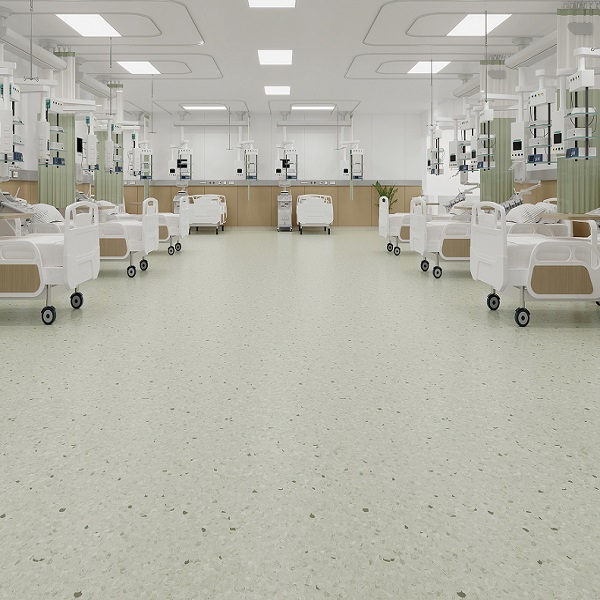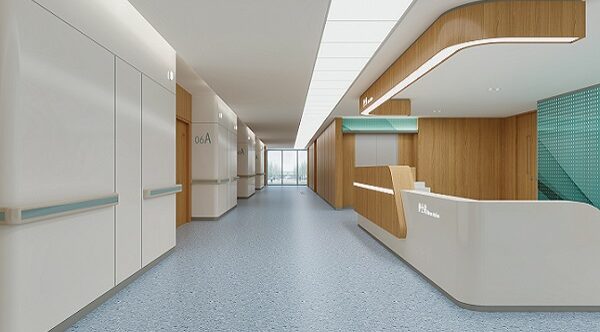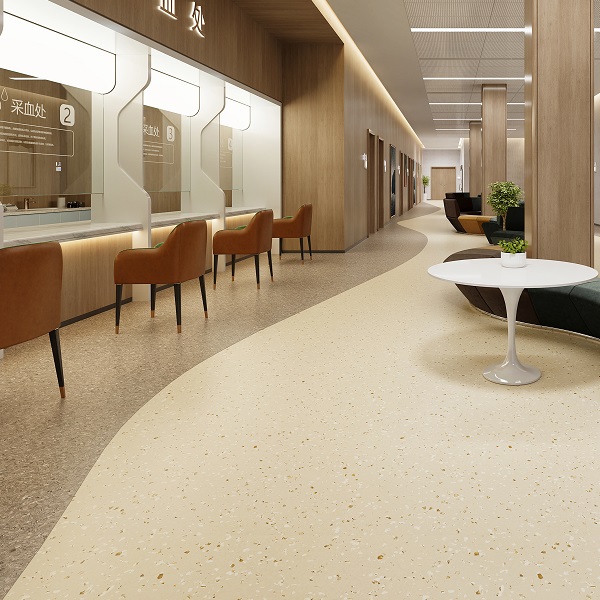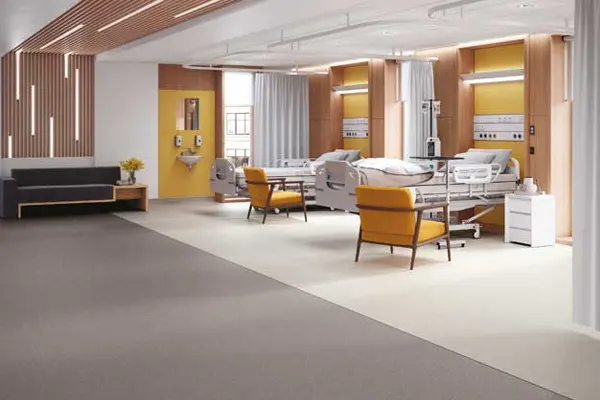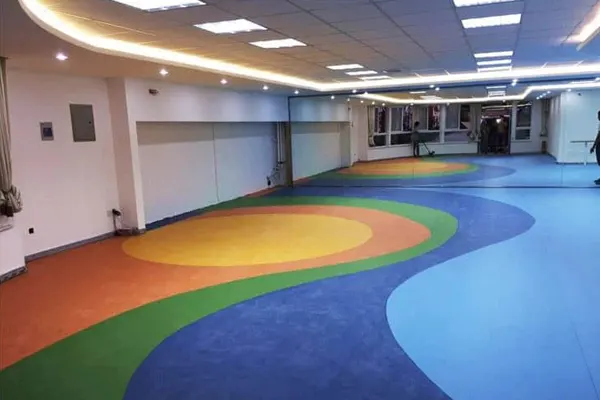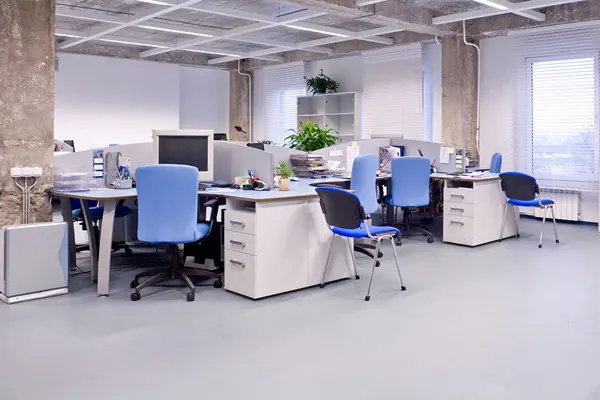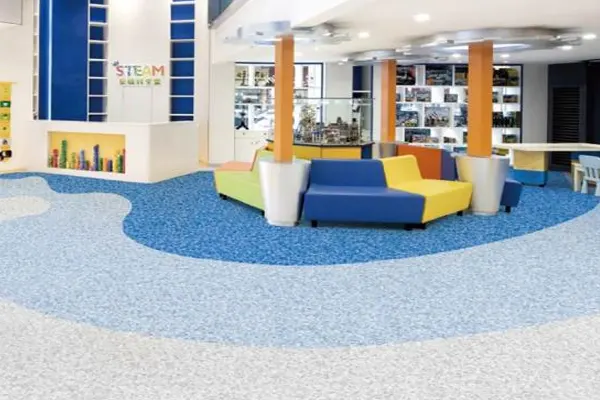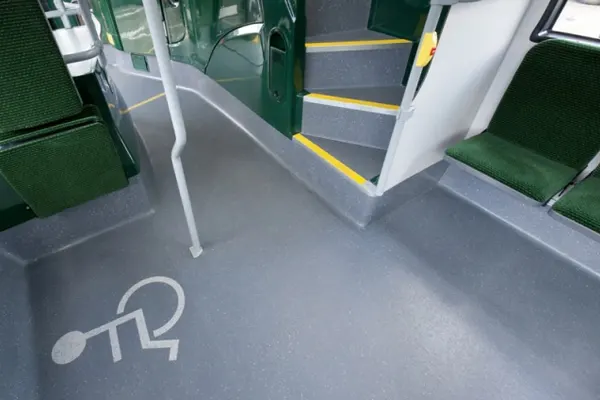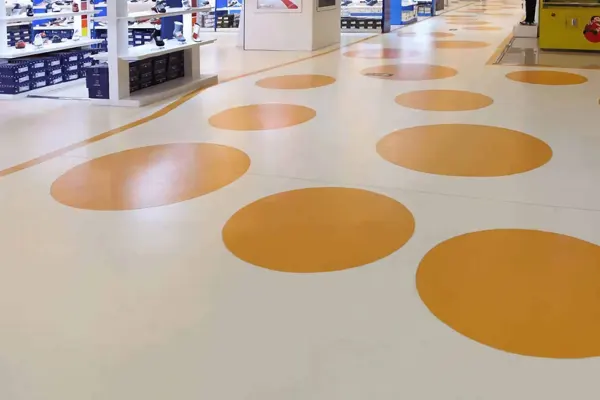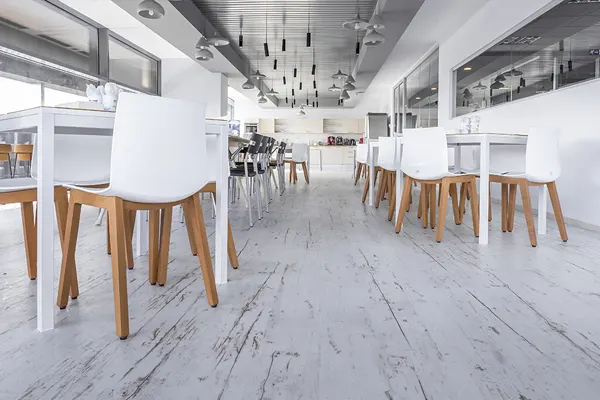Homogeneous PVC flooring
Looking for unique homogeneous PVC flooring solutions? We are your ideal partner. As a professional PVC flooring factory, we possess advanced production equipment and a skilled technical team, enabling us to customize homogeneous PVC flooring in various specifications, colors, and patterns to meet our clients' specific needs. We continuously innovate and actively develop new products to satisfy the evolving demands of the market. Whether you require ultra-durable flooring for high-traffic areas or specialized anti-static or antibacterial flooring for sensitive environments, we can provide you with professional solutions.
The above is just a part of our Homogeneous PVC flooring products. If you want to learn more or have special customization needs, please contact us immediately.
FAQs About Homogeneous PVC flooring
What are the standard thicknesses available for your homogeneous PVC flooring?
The standard thicknesses available for homogeneous PVC flooring are as follows:
-2.0 mm: This is a commonly available and widely used thickness. It is suitable for various commercial and public areas such as hospitals, factories, schools, offices, and workshops. For example, in a normal office environment with moderate foot traffic, 2.0 mm thick homogeneous PVC flooring can provide good durability and aesthetics.
-2.5 mm: It offers slightly more thickness and durability compared to 2.0 mm, providing better resistance to wear and tear. It can be used in places with relatively higher foot traffic or where a bit more cushioning is desired, like some busy corridors in schools or hospitals.
-3.0 mm: This thickness provides enhanced durability and can better withstand heavier use and more significant impacts. It is often preferred for areas with high foot traffic, such as large shopping malls, supermarkets, and transportation hubs, where the flooring needs to endure constant pressure from a large number of people.
What are the available roll widths and lengths?
The available roll widths and lengths of homogeneous PVC flooring are as follows:
Widths:
-2 meters: One of the most popular widths. It offers good coverage and is widely used in various commercial and public areas due to its relatively wide coverage and ease of installation, such as hospitals, schools, and shopping malls.
Lengths:
-20 meters: One of the standard lengths available. It is widely used for larger projects as it can cover significant areas, reducing the number of seams and providing a more seamless look, which is highly desired in many commercial and public spaces.
What is the wear layer thickness and what abrasion resistance standards (e.g., EN 660-1, ASTM F970) does it meet?
The wear layer thickness of PVC flooring typically ranges from 0.15mm to 1.0mm.
Different products and applications may have different wear layer thickness requirements:
– For general commercial areas with moderate foot traffic, such as small offices and shops, a wear layer thickness of around 0.3mm – 0.5mm is often sufficient. This can provide a good balance between cost and durability, lasting for several years under normal use conditions.
– In high-traffic public areas like shopping malls, hospitals, and schools, a thicker wear layer of 0.5mm-1.0mm is usually preferred. This can better withstand the heavy wear and tear caused by a large number of people walking, ensuring the flooring maintains its appearance and performance for a longer time.
Regarding abrasion resistance standards, the two main standards mentioned in your question are EN 660-1 and ASTM F970:
EN 660-1
-Test method: In this test, sand is sprinkled on the tested material, and then a leather wheel is used for testing. After 5000 rotations, the thickness loss of the wear layer is detected.
-Classification: PVC flooring can be classified into four abrasion resistance grades according to EN 660-1, namely T, P, M, and F grades. The smaller the thickness loss value, the higher the abrasion resistance level and the better the product quality.
T grade: The thickness loss is Fv ≤ 0.08mm. T grade products have the highest abrasion resistance and are suitable for areas with extremely high traffic or where long-term durability is required, such as large shopping malls, airports, and railway stations.
P grade: 0.08mm < Fv ≤ 0.15mm. P grade products also have relatively good abrasion resistance and can be used in areas with heavy traffic, like hospitals, schools, and office buildings.
M grade: 0.15mm < Fv ≤ 0.30mm. M grade products have moderate abrasion resistance and are suitable for areas with moderate foot traffic, such as some small to medium-sized commercial areas.
F grade: 0.30mm < Fv ≤ 0.60mm. F grade products have relatively lower abrasion resistance and are generally used in areas with light traffic or where the requirements for abrasion resistance are not extremely high.
ASTM F970
Test method: This standard also evaluates the abrasion resistance of flooring materials through specific testing equipment and methods. It measures the wear volume or weight loss of the sample after a certain number of abrasion cycles to determine its abrasion resistance performance.
Classification: Different products may have different performance levels according to ASTM F970. Generally, products with better abrasion resistance will have lower wear volume or weight loss values after testing, indicating their ability to withstand abrasion better.
What is the fire resistance rating of your homogeneous PVC flooring?
Fire – resistance classification systems
– Homogeneous PVC flooring is usually classified according to different fire – resistance standards. In Europe, the common standard is EN 13501-1. Under this standard, the fire – resistance rating can range from Class A1 (non-combustible) to Class F (combustible).
– In the United States, standards such as ASTM E84 are often used to evaluate the surface burning characteristics of building materials, including flooring.
Typical fire – resistance ratings for homogeneous PVC flooring
– Many homogeneous PVC flooring have a fire-resistance rating of Class Bfl – s1 in the EN 13501 – 1 classification.
-Bfl: This indicates that the material is combustible. However, in the case of homogeneous PVC flooring with a Bfl rating, it has a certain level of fire performance. For example, it burns in a limited way and does not contribute to a rapid spread of fire.
-s1: The “s1” classification refers to the production of limited smoke and no burning droplets or particles. This means that when the flooring is exposed to a fire source, it will not release a large amount of smoke that could endanger lives by reducing visibility and inhalation risks. It also will not produce burning droplets that could spread the fire to other areas.
– Some high – quality or specially treated homogeneous PVC floorings may achieve a Class Cfl – s1 rating, which is a better fire – performance classification than Bfl-s1. The “Cfl” rating means that the material has a lower rate of heat release during combustion compared to Bfl- rated materials, providing more fire-safety benefits.
It’s important to note that the actual fire – resistance rating can vary depending on the specific product formulation, additives used in the PVC flooring, and the testing conditions. Manufacturers usually provide detailed fire – test reports and certifications for their products to ensure compliance with relevant building codes and safety requirements.
What are the slip resistance ratings (e.g., R-value, DS) and test methods used?
The slip resistance ratings and test methods for homogeneous PVC flooring are as follows:
Slip Resistance Ratings
-R-value: In the DIN 51130 standard, the R-value is used to classify the slip resistance of flooring. The ratings and their corresponding tilt angles are as follows :
-R9: Low slip resistance, with a tilt angle between 6 – 10 degrees.
-R10: Normal slip resistance, with a tilt angle between 10 – 19 degrees.
-R11: Above-average slip resistance, with a tilt angle between 19 – 27 degrees.
-R12: High slip resistance, with a tilt angle between 27 – 35 degrees.
-R13: Very high slip resistance, with a tilt angle greater than 35 degrees.
-DS: In the AS 4586 standard, the Dry Floor Friction Test Method classifies the dry slip resistance of flooring using D-values. There are two levels :
-D1: The average friction coefficient is ≥0.40.
-D0: The average friction coefficient is <0.40.
Test Methods
-EN 13893: This is a standard test method for determining the slip resistance of flooring surfaces in dry conditions. It measures the static coefficient of friction between a standard test foot and the flooring surface to evaluate the dry slip resistance performance.
-DIN 51130: The ramp test method described in DIN 51130 is used to assess the slip resistance of flooring. In this test, the sample is placed on an inclined plane, and the angle at which the test object starts to slide is measured. Based on this angle, the slip resistance rating (R-value) of the flooring is determined.
– AS 4586: This standard includes two test methods for slip resistance. The Wet Pendulum Test Method measures the slip resistance value (SRV) under wet conditions using a pendulum tester, with different slider conditions corresponding to different P-values. The Dry Floor Friction Test Method measures the average friction coefficient under dry conditions to determine the D-value.
-GB/T 4100: This standard specifies the test method for the slip resistance of ceramic tiles. Although it is mainly for ceramic tiles, some of the principles and methods can also be used for reference in the evaluation of PVC flooring slip resistance. It may involve measuring the static friction coefficient or using other similar methods to assess the ability of the surface to prevent slipping.
-ASTM C1028: ASTM C1028 is a standard test method for determining the static coefficient of friction of ceramic tile and other like surfaces by the horizontal dynamometer pull-meter method. Similar to GB/T 4100, it can provide a reference for evaluating the slip resistance of PVC flooring, mainly by measuring the static friction coefficient to judge the slip resistance performance.
What are the chemical resistance properties of the flooring?
Homogeneous PVC flooring has good chemical resistance properties:
-It resists common chemicals like weak acids and bases well, suitable for areas with mild chemical exposures.
-It’s highly stain resistant against substances like ink and food dyes.
-It can tolerate various common cleaning agents.
-It has some resistance to organic solvents, though excessive exposure may cause issues.
-Some high-quality ones resist iodine and medical reagents, ideal for medical facilities.
What is the dimensional stability of the flooring under temperature and humidity changes?
Temperature Effects
-PVC flooring expands with rising temperature (coefficient of thermal expansion is $(7 – 10)×10^{-5}\text{ m/m/°C}$) and contracts in low temperatures. In normal indoor settings, expansion is manageable, but extreme conditions can cause issues like gaps.
Humidity Effects
-It absorbs moisture and expands with increasing humidity and contracts with decreasing humidity. In very humid or dry environments, this can lead to warping or cracking. Manufacturer’s Specs
-Manufacturers provide dimensional stability specs, like a maximum expansion or contraction rate (e.g., ±0.1% – ±0.3%) under normal temperature and humidity ranges (18-28°C and 40% – 60%).
Installation
-Installers leave 3-5 mm expansion gaps and may use special techniques or underlayments in areas with significant temperature and humidity fluctuations.
Does your flooring contain any harmful substances like phthalates or heavy metals?
Our flooring generally does not contain harmful substances such as phthalates or heavy metals, but it depends on the specific type and quality of the flooring:
Phthalates
-Low-quality PVC flooring: Some low-quality PVC floors may use phthalate-based plasticizers like DOP (dioctyl phthalate), which can potentially release phthalates. In 2024, the Liaoning Provincial Market Supervision Administration found that 6 out of 15 batches of PVC floor samples contained dibutyl phthalate, and 2 batches exceeded the standard.
-High-quality PVC flooring: Reputable manufacturers often use alternative plasticizers such as DOTP (dioctyl terephthalate), which is non-toxic and environmentally friendly, eliminating the risk of phthalate release.
Heavy Metals
-Pure PVC resin: The core raw material of PVC flooring, polyvinyl chloride resin powder, does not contain heavy metals.
-Recycled materials: If recycled plastics or building materials are used in the production process and not properly treated, heavy metal content may exceed the standard.
What is the density of the material?
Density of Homogeneous PVC Flooring
– The density of homogeneous PVC flooring typically ranges from 1.3-1.5 g/cm³. This density range is affected by several factors such as the formulation of the PVC resin, the type and amount of additives used.
What is the impact resistance of the Homogeneous PVC flooring?
Homogeneous PVC flooring has excellent impact resistance, and its specific manifestations are as follows:
-Good elastic recovery: Homogeneous PVC flooring is made of polyvinyl chloride resin and other materials, which endows it with good elasticity. When subjected to the impact of heavy objects, it can quickly recover to its original shape without obvious deformation. For example, when a heavy object is accidentally dropped on the floor, the floor will only show a slight indentation at the moment of impact, and then quickly return to flat.
-Reduction of damage to the human: This kind of flooring can effectively disperse the impact force on the feet when people walk or run on it. It minimizes the impact of the ground on the human body, reducing the risk of injury to the feet, ankles, knees and other parts. Especially in places with a large flow of people, such as shopping malls, schools, and hospitals, it can significantly reduce the probability of people slipping and falling and getting injured.
-No damage under normal impact: It has strong resistance to various impacts in daily use. Whether it is the impact of furniture being moved, the collision of sports equipment, or the accidental dropping of items, homogeneous PVC flooring can maintain its integrity and will not be easily damaged, such as cracking, chipping or leaving permanent marks.
-Long service life: Thanks to its excellent impact resistance, homogeneous PVC flooring has a relatively long service life even under high-frequency impact conditions. It can maintain good performance and appearance for a long time, reducing the frequency of replacement and saving costs.
What raw materials are used in the production of your homogeneous PVC flooring?
Polyvinyl Chloride (PVC) Resin: The main material, available as powder or granules. Different grades affect product characteristics. High-quality resin leads to better performance.
Plasticizers: Such as dioctyl terephthalate (DOTP), used to improve flexibility and work-ability. The amount affects the floor’s softness.
Fillers: Commonly calcium carbonate. It improves hardness, stability, and abrasion resistance and reduces cost. Particle size matters for surface finish and strength.
Stabilizers: Heat stabilizers (e.g., organotin or calcium-zinc) prevent PVC degradation. UV stabilizers can be added for sunlight resistance.
What quality control measures are in place during the manufacturing process?
Raw Material Inspection: Check PVC resin’s purity, viscosity, etc. Inspect additives like plasticizers and fillers for quality and compatibility.
Production Process Monitoring: Monitor mixing for uniformity, control extrusion parameters, and manage heat pressing and cooling precisely.
Product Testing:
-Physical Properties: Test thickness, dimensional accuracy, hardness, and density.
-Performance: Assess abrasion, impact, slip, and chemical resistance.
Quality Assurance System:
-Certifications: Adhere to standards like ISO 9001.
-Traceability: Track materials and production data.
-Final Inspection: Check for visible defects before shipping.
Do you have ISO 9001 or other relevant quality management certifications?
Some manufacturers of homogeneous PVC flooring indeed possess ISO 9001 certification. For instance, certain well-known brands have obtained the ISO 9001 Quality Management System Certification. This certification showcases that their production processes adhere to strict international quality management standards, ensuring the consistent quality of their homogeneous PVC flooring products from raw material procurement to the final finished goods.
Besides ISO 9001, there may also be other relevant certifications depending on the specific requirements and target markets. For example, they might have certifications related to environmental protection like ISO 14001 (Environmental Management System Certification) if they focus on sustainable production and minimizing environmental impact. There could also be certifications regarding occupational health and safety such as OHSAS 18001 (Occupational Health and Safety Assessment Series) to demonstrate a safe working environment during the manufacturing process.
What is your production capacity and lead time for large orders?
Production Capacity: The company has production base in Inner Mongolia , with a factory area of 700,000 square meters and dozens of production lines of world-advanced level, indicating a relatively large production scale.
Lead Time: It can arrange shipments within 5 days after successful payment.
What is your minimum order quantity (MOQ)?
Our minimum order quantity is 40 square meters.
Can you provide samples of your flooring products?
Yes, the samples are provided free of charge by us, but the buyer has to bear the freight.
What are your pricing terms (e.g., FOB, CIF)?
Our pricing term includes FOB, FCA, EXW,CIF,CFR,DDP,DAP.
What payment methods do you accept?
We accept TT, PAYPAL, ALIPAY, ALIBABA.
What are your packaging options for shipping?
The single-roll product is packed in kraft paper with a cushioned foam shell. Then we use pallet packing, includes 4, 10 or 16 rolls’ patterns.
Can you assist with shipping and customs documentation?
Yes, we can assist with shipping and customs documentation.
Is the issue you are looking for regarding Homogeneous PVC flooring not included in the above list? Do you want to know about some other Homogeneous PVC flooring issues? Please contact us immediately and we will provide you with satisfactory answers.
Application fields of Homogeneous PVC flooring
Do you want to know more about the application areas of Homogeneous PVC flooring? Do you want to know if LIFLOR’s PVC flooring can meet your requirements? Welcome to contact us immediately, we will provide you with satisfactory answers.
Have Anything To Ask Us?
Please fill in the detailed information in the form,
and we will contact you as soon as possible

